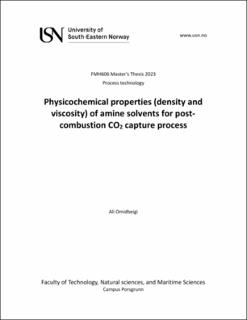| dc.description.abstract | Carbon capture technologies are becoming increasingly important as the negative effects of greenhouse gas emissions on the environment and human health become more evident. A key component of carbon capture processes is amine solvents, and understanding their physicochemical properties is crucial to improving the efficiency and effectiveness of carbon capture systems. By studying these properties, researchers can develop improved solvents that enhance carbon capture efficiency and optimize the design of carbon capture systems for specific industrial applications.
The focus of this work is to measure the density and viscosity of Monoethanolamine (MEA) and 2-amino-2-methyl-1-propanol (AMP). The experiments began by measuring the density of MEA and AMP at weight fractions from 0.3 up to 1 and a temperature range of 303.15 K up to 353.15 K using an Anton Paar DMA 4500 density meter. The viscosity was measured at same weight fractions and temperature range using an Anton Paar MCR 101 rheometer and compared with relevant literature resources.
The results of the density measurements for MEA were compared with two relevant previous works, revealing an average absolute relative deviation (AARD) and absolute maximum deviation (AMD) between all the data of this work and data from both sources of 0.03% and 0.284 AMD in comparison with one source and 0.03% and 0.2843 with the other. The results of AMP could be compared with only one previous work due to the lack of available articles for this amine, and the AARD and AMD were found to be 0.22% and 9.2 , respectively.
Mathematical models were developed for each set of measurements. For density, Redlich-Kister polynomial and Aronu, Hartono, and Svendsen equation (Aruno model) were suggested. The fitted curves and calculations showed an AARD of 0.05% and AMD of 2.85 for aqueous MEA using the Redlich-Kister model, while the Aruno model values were found to be 0.02% and 5.46 . For aqueous AMP, the Redlich-Kister model showed 0.16% AARD and 10.55 AMD, and the Aruno model had 0.12% AARD and 9.24 AMD.
In viscosity modeling, Eyring's viscosity model and Arrhenius equation were investigated. In both cases of MEA and AMP solutions, the Arrhenius equation showed more satisfactory results, with an AARD of 9.86% for MEA and 3.76% for AMP. The AMD values were 1.94 mPa.s and 4.28 mPa.s, respectively.
At the final step, this study suggests expanding experimental investigations and advancing mathematical modeling for future work. Some weak points identified and to address these issues, the study includes recommendations such as, investigating properties of mixtures of AMP and MEA, studying CO2 loaded AMP solutions, and evaluating other well-known viscosity and density models. | |
